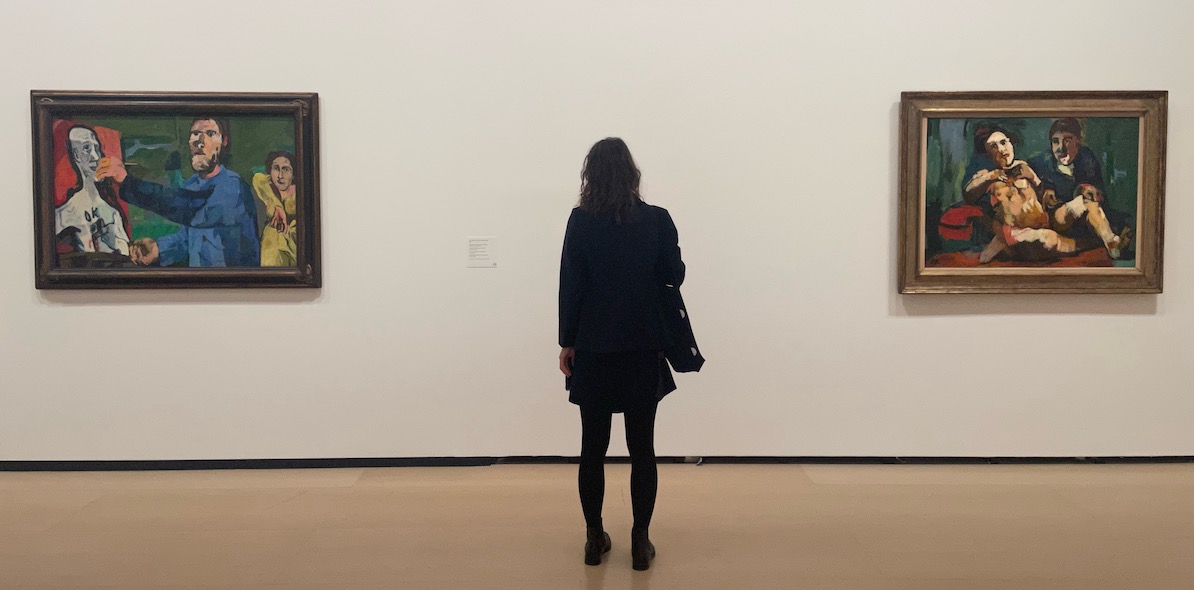Oskar Kokoschka (1886-1980) is best known for his early links to the Viennese art scene, where Gustav Klimt encouraged and supported him and where he, in turn, exerted an influence on Egon Schiele. He is also associated with his infamous doomed affair with Alma Mahler, the widow of the composer Gustav Mahler. Yet by the end of the First World War in 1918, Klimt and Schiele were dead, and Alma Mahler had married the architect Walter Gropius.
His portraits have the power to disrupt and disturb.
Kokoschka went on to create work throughout most of the 20th century, living almost a nomadic life moving around Europe from Vienna to Dresden, Prague, England and finally, Switzerland. He constantly reinvented himself and produced a revolutionary body of art, responding to the world around him, particularly the far-reaching effects of a changing Europe during and after two world wars. He was multifaceted, a painter, a playwright, a poet, a teacher, an observer, a rebel, an activist and a humanist. His early Expressionist portraits showed him as ‘the painter of souls’.

The retrospective at The Guggenheim Bilbao presents a chronological history of Kokoschka’s work. It is divided into sections six sections: An “enfant terrible” in Vienna (1907-16), The Dresden Years (1916-23), Journeys (1923-1934), Resistance in Prague (1934-1938), Exile in England (1938-46) and A European Artist in Switzerland (1946-80). The show has deliberately underplayed his relationship with Alma Mahler (There is only one small exquisite drawing of her) to emphasise his far-reaching body of work and influence on a subsequent generation, particularly the Neo-Expressionists of the 1980s.
What abounds throughout the exhibition is his restless palette, the intensity of brushstrokes, expressive lines and a passionate connection with the subject of his works. His portraits have the power to disrupt and disturb. In the early Viennese portraits, he broke with the tradition of using a brush or palette knife and painted with his fingertips, palm of his hand, nails, and the back of a brush or cloth. The eyes are always impassioned, while the hands express the sitter’s life. The Prisoner of 1914 is an astonishing painting with its dark palette and solid oversized hands forming the centre of the painting.
Similarly, the Self-portraits have a provocative intensity. Kokoschka consistently used Self-portraiture to work through the traumas of his life: the horrors of war, the treatment of artists by the Fascists and the effects war left on Europe. Again and again, the world is reflected through the eyes and hands, a consistency that remains even though his style adapts and changes.
In Dresden, he discovered colour. After being seriously wounded during the First World War, he moved to Dresden to convalesce. He gained a foothold in the art scene and became a Professor at the Academy of Fine Arts. The Painter and Model II of 1923 is an extraordinary self-portrait depicting himself revisiting an earlier gouache from 1909. Here he is with a shaved head, a rebel of Viennese society, yet the present-day Kokoschka almost blocks our view with his arm, while the model in the title is relegated to the sidelines, only half in the picture.

After Dresden, Kokoschka spent the next few years travelling across Europe, North Africa and the Middle East. The resulting works had stronger lines and a more subdued palette. Landscapes became portraits of the cities. Two different views of Marseilles seen from above show that he is trying to analyse the city in an attempt to find its core. A standout painting from these years is the Tigon of 1926. He saw the tiger lion at the London zoo. The animal is too large for the canvas, appearing to spring out of it, his face taking centre stage and connecting directly with the viewer.
As the world headed towards another war, Kokoschka continued to move around, first returning to Vienna, but the political unrest there led him to move on to Prague. He became an activist publishing articles and organising conferences alerting people to the dangers of the Nazis’ stranglehold on Europe. His work was included in the travelling exhibition of degenerate art alongside many other works of the European avant-garde. His response was the 1937 Self-Portrait of a Degenerate Artist. His challenging gaze at the viewer bares his soul, the posture of his crossed arms defiant, the brushstrokes assured, uniting form, colour and tone.
He moved to England, where he stayed throughout the Second World War. His political activism continued by writing commentaries and speeches declaring his pacifism. In his paintings, he created a series of angry, emotional political allegories sharply denouncing the situation in Europe. In Alice in Wonderland of 1942, a nude figure on the left, three men wearing hard hats in the centre representing hear no evil, speak no evil, see no evil, a baby wearing a gas mask, and a burning temple with the words Wien (Vienna) on the front make up this complex, busy, highly charged painting.
After the war, Kokoschka and his wife Olda settled in Switzerland. In 1948 a travelling exhibition around the USA ending at the MoMA New York confirmed his status as an international artist. His interest in Old Masters and Classical Greek and Roman antiquities became a source of inspiration. As a result, he began to paint mythological tales and Greek tragedies and, at the same time, renewed his colour palette. His colours become brighter with intense yellows, reds and oranges in paintings such as Theseus and Antiope (the Rape of Antiope) 1958-75.
Time, Gentleman Please of 1971-72 is one of his last paintings and neatly sums up his style. It maintains elements of Expressionism and Symbolism with brushstrokes containing a sense of movement inherited from the Baroque, producing an image of enormous vitality and power while advocating figurative painting.
Oskar Kokoschka: A Rebel From Vienna, Guggenheim Bilbao 17 March – 3 September 2023

